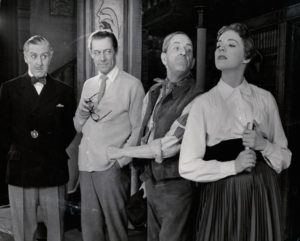
We mark the opening performance on March 15, 1956 – 65 years ago today – of the Broadway musical My Fair Lady at the Mark Hellinger Theater, which was located at 237 West 51st Street in mid-town Manhattan, New York City. (For our information, since 1989, the theater has been the home of the Times Square Church.) Originally starring Julie Andrews, Rex Harrison, and Stanley Holloway, this first Broadway production of My Fair Lady (there have been four Broadway revivals) ran for what was then a record-breaking 2717 performances – for 6½ years! – until September 29, 1962. (Because we all want to know: the current record holder is Phantom of the Opera, which opened on January 26, 1988 and continues to run at the Majestic Theater. Currently suspended due to the pandemic, the Broadway production of Phantom has thus far racked up an astonishing 13,370 performances. Whoa!)
My Fair Lady is routinely called “the perfect musical”, and who are we to argue with that appraisal? Speaking for myself, I saw that first Broadway production in April of 1962; attendance was my eighth birthday present. Though Julie Andrews, Rex Harrison, and Stanley Holloway had long before left the show, it was, nevertheless, pure magic for me then and remains so to this day. Tomorrow’s Dr. Bob Prescribes post will delve into the actual creation of My Fair Lady. For the remainder of this post, we’re going to explore the issues and complexities surrounding the making of a musical partnership: Alan Jay Lerner (1918-1986, who wrote the “book” – the libretto – and the lyrics for My Fair Lady) and Frederick “Fritz” Loewe (1901-1988, who composed its music).

“Lerner and Loewe.” “Gershwin and Gershwin.” “Rodgers and Hart.” “Rogers and Hammerstein.” “Adler and Ross.” “Bock and Harnick.” “Kander and Ebb.” The great Broadway teams have become legends, and their music is woven into the very fabric of our culture. We hear (and say) these names together so often that they merge into a single name: “Lernerandloewe.” But a singularity these teams are not, and never did two more different people collaborate with each other on Broadway musicals than in the case of Alan Jay Lerner and Fritz Loewe.
Let’s get the numbers out of the way. Lerner and Loewe worked together for an aggregate of twenty years, from 1942 to 1960 and then again from 1970 to 1972. Together, they wrote nine musicals, five of which were major hits: Brigadoon (1947), Paint Your Wagon (1951), My Fair Lady (1956), Camelot (1960), and Gigi (1973). Between the two of them, Alan Jay Lerner and Fritz Loewe received three Tony Awards, three Academy Awards, two Grammy Awards, three Golden Globes, and two New York Drama Critics’ Circle Awards.
We would begin with what Alan Lerner and Fritz Loewe had in common.
They were both rather short – Lerner around 5’5” and Loewe about 5’4” – and they both boxed when they were young men.
That’s it; commonalities complete.
Loewe was an Austrian who didn’t come to the United States until he was 23, in 1924; he had the manners and mannerisms of a central European gentleman, and he was subject to depression. Lerner was born in New York City and had a New Yorker’s sense of outgoing brashness. As an Austrian Loewe had suffered considerable deprivation during World War One (1914-1918), whereas Lerner grew up in the lap of luxury and entitlement. Loewe was married and divorced once; Lerner was married eight times. (Looking back, the composer Burton Lane once remarked:
“Alan was a very complicated fellow. Every time I would start to work with him, he was divorcing one wife and marrying the next one.”)
Loewe was a classically trained piano prodigy and composer; Lerner’s “training” consisted of attending the theater and developing his craft as a writer on his own.
And yet these two most different men, with radically different personalities, backgrounds, and training, became one of the greatest writing teams in the history of American Theater.…
Continue reading, only on Patreon!
Become a Patron!Listen on the Music History Monday Podcast
Podcast: Play in new window
Subscribe: Apple Podcasts | Spotify | Pandora | iHeartRadio | RSS | More
